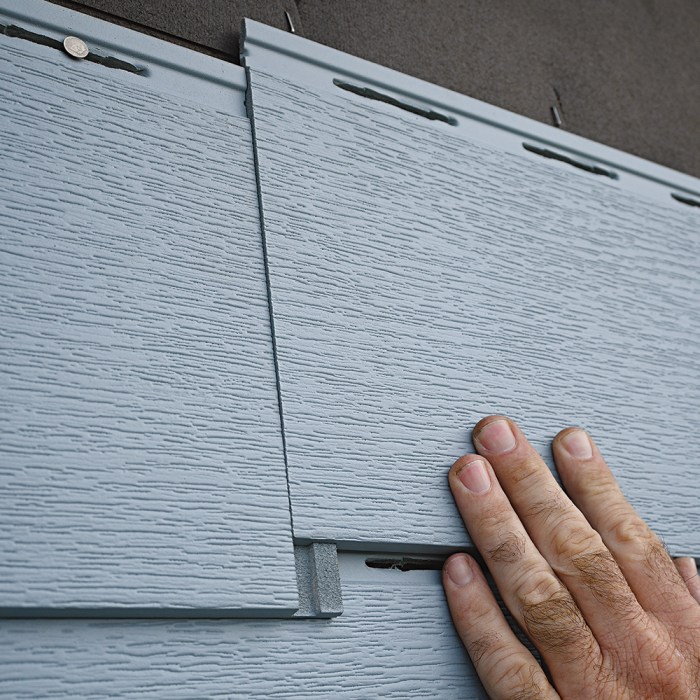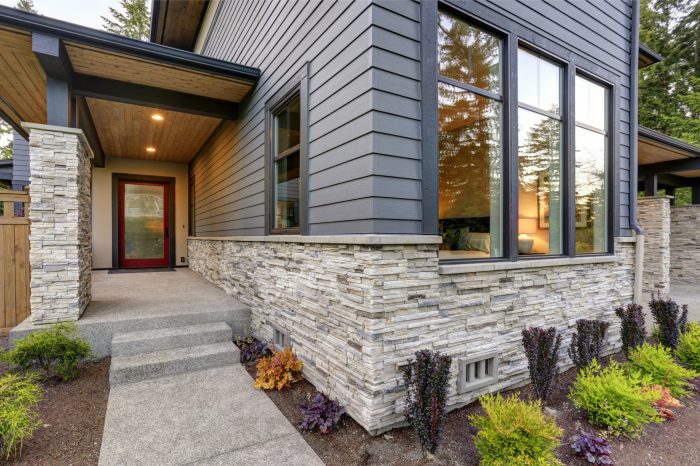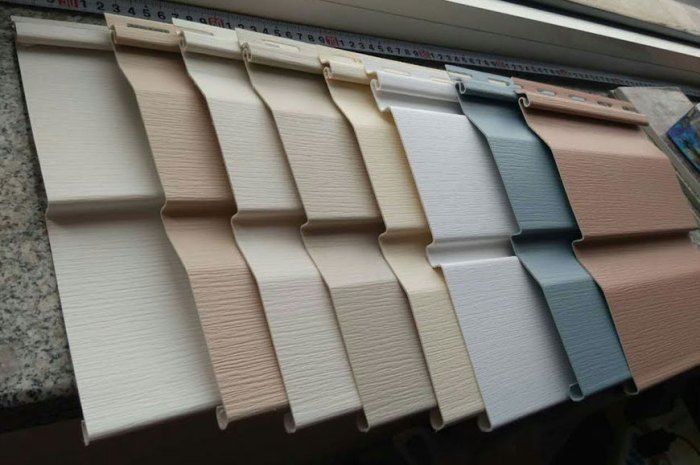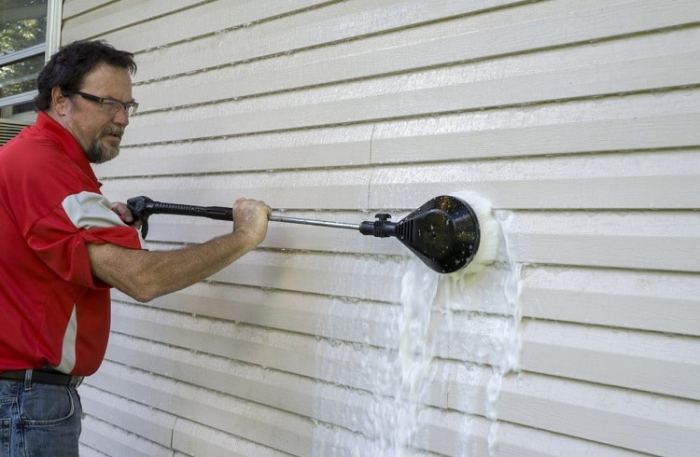Vinyl fascia, a popular exterior cladding material, offers a compelling blend of aesthetics, durability, and cost-effectiveness. This comprehensive guide delves into the multifaceted world of vinyl fascia, exploring its composition, installation, design considerations, and long-term maintenance. From understanding its material properties and manufacturing process to mastering installation techniques and addressing common problems, we provide a detailed overview to help you make informed decisions about this versatile building product.
We’ll examine the various factors influencing the lifespan and performance of vinyl fascia, including the impact of UV stabilizers and the importance of proper installation. Furthermore, we’ll explore design aesthetics, comparing different profiles, colors, and textures to showcase the versatility of vinyl fascia in enhancing the curb appeal of any home. Finally, we’ll analyze the cost-benefit analysis, considering sustainability and environmental impact alongside its economic advantages.
Vinyl Fascia

Vinyl fascia, a popular exterior cladding material, offers a durable and aesthetically pleasing alternative to traditional materials like wood and aluminum. Its widespread use stems from a combination of cost-effectiveness, low maintenance requirements, and a variety of available colors and styles. This section delves into the material properties, composition, and manufacturing process of vinyl fascia, comparing its performance characteristics to other common cladding options.
Vinyl Fascia Composition and Additives
Vinyl fascia is primarily composed of polyvinyl chloride (PVC), a thermoplastic polymer. However, pure PVC lacks the necessary properties for exterior applications, requiring the addition of various additives to enhance its performance and longevity. These additives typically include: heat stabilizers (to prevent degradation at high temperatures), UV stabilizers (to protect against sunlight damage), lubricants (to improve processing during manufacturing), pigments (to provide color), and impact modifiers (to increase resistance to damage). The precise formulation varies depending on the manufacturer and desired properties of the final product. For example, a fascia intended for high-UV regions might contain a higher concentration of UV stabilizers than one used in a less sunny climate.
Vinyl Fascia Manufacturing Process
The manufacturing process of vinyl fascia involves several key steps. First, the raw PVC resin and additives are thoroughly mixed in a high-speed mixer. This mixture is then extruded through a specialized die, forming a continuous profile that matches the desired fascia shape. The extruded profile is then cooled and cut into lengths. Depending on the manufacturer and product specifications, additional steps such as embossing (to create a textured surface) or painting may be included. Finally, the finished fascia is inspected and packaged for distribution. The entire process is highly automated to ensure consistent quality and high production volumes.
Physical Properties of Vinyl Fascia Compared to Other Cladding Materials
Vinyl fascia exhibits a unique combination of physical properties. Compared to aluminum, it offers superior impact resistance, but it is less strong and rigid. Against wood, vinyl fascia offers greater resistance to rot, insect infestation, and moisture damage, but it is less aesthetically versatile in terms of natural grain and texture. In terms of flexibility, vinyl fascia demonstrates moderate flexibility, allowing it to conform to slightly curved surfaces, unlike rigid aluminum. Its UV resistance, largely dependent on the type and concentration of UV stabilizers, is generally good, but prolonged exposure to intense sunlight can still lead to some degree of color fading over many years.
Impact of UV Stabilizers on Vinyl Fascia Longevity and Color Retention
The selection and concentration of UV stabilizers significantly influence the longevity and color retention of vinyl fascia. Different types of UV stabilizers offer varying degrees of protection. For instance, carbon black is a highly effective UV stabilizer, but it limits the range of available colors. Other stabilizers, such as hindered amine light stabilizers (HALS), provide good UV protection while allowing for a wider color palette. The use of high-quality, appropriately concentrated UV stabilizers is crucial for maximizing the lifespan and maintaining the color of vinyl fascia, particularly in regions with high solar radiation. Fascia with inadequate UV protection will show noticeable fading and degradation within a few years, while those with superior UV protection may retain their color and integrity for decades.
Vinyl Fascia

Vinyl fascia, a popular choice for exterior home improvement, offers a durable and low-maintenance alternative to traditional materials like wood. Its resistance to rot, insects, and extreme weather conditions makes it a cost-effective long-term solution. Understanding proper installation and maintenance techniques is crucial to maximizing its lifespan and aesthetic appeal.
Vinyl Fascia Installation
Installing vinyl fascia requires careful planning and execution to ensure a professional-looking and long-lasting result. Improper installation can lead to issues such as warping, cracking, and premature failure. Before beginning, always consult the manufacturer’s instructions for specific recommendations.
The following steps provide a general guide for installing vinyl fascia:
- Preparation: Measure the area carefully and purchase enough vinyl fascia to cover the entire length, accounting for overlaps and waste. Remove any existing fascia and clean the underlying surface. Ensure the underlying structure is sound and free from rot or damage.
- Tools and Materials: Gather the necessary tools and materials. A comprehensive list is provided in the table below.
- Installation: Start by installing the end caps, followed by the main fascia boards. Use appropriate fasteners, ensuring they are not overtightened, which could cause cracking. Overlap boards according to manufacturer’s specifications. Maintain consistent spacing and alignment throughout the installation process.
- Securing: Secure the fascia boards using appropriate fasteners. Avoid over-tightening, which can cause warping or cracking. Use sealant to create a watertight seal between the fascia and the underlying structure.
- Finishing: Inspect the installation carefully for any gaps or misalignments. Apply caulk to seal any gaps and ensure a watertight seal.
| Item | Quantity | Notes |
|---|---|---|
| Vinyl Fascia Boards | As needed, based on measurements | Choose appropriate length and color |
| End Caps | As needed | Match the fascia boards |
| Fasteners (nails or screws) | Sufficient for secure installation | Use galvanized or stainless steel fasteners for exterior use |
| Measuring Tape | 1 | Accurate measurements are crucial |
| Saw (circular saw or hand saw) | 1 | For cutting fascia boards to length |
| Caulk | 1 tube | Exterior-grade caulk to seal gaps |
| Safety Glasses | 1 pair | Protect eyes from debris |
| Work Gloves | 1 pair | Protect hands |
Common Installation Challenges and Solutions
Several challenges can arise during vinyl fascia installation. Understanding these challenges and their solutions is essential for a successful project.
For instance, improper cutting can lead to uneven fascia lines. Using a sharp saw and making precise measurements can mitigate this issue. Similarly, working in extreme temperatures can cause the vinyl to become brittle or expand, leading to difficulty in installation. Working during moderate temperatures is recommended. Finally, failing to properly seal gaps can lead to water damage. Using a high-quality exterior-grade caulk is essential.
Vinyl Fascia Maintenance and Cleaning
Regular cleaning and maintenance are crucial for prolonging the lifespan of vinyl fascia. Neglecting maintenance can lead to discoloration, staining, and premature deterioration.
Cleaning should be done regularly using a mild detergent and water solution. A soft-bristled brush can be used to remove stubborn dirt and debris. Avoid using harsh chemicals or abrasive cleaners, as these can damage the vinyl surface. Regular inspection for any signs of damage or deterioration is also recommended. Addressing minor issues promptly can prevent more significant problems down the line.
Potential Issues from Improper Installation or Maintenance
Improper installation or inadequate maintenance can lead to various problems. These can range from minor aesthetic flaws to significant structural issues.
For example, improper fastening can cause the fascia to loosen or detach, potentially leading to water damage to the underlying structure. Similarly, neglecting to seal gaps can allow water to penetrate, causing rot and damage to the building’s structure. Finally, using harsh chemicals or abrasive cleaners can damage the vinyl’s finish, leading to premature fading and discoloration.
Vinyl Fascia
Vinyl fascia, a crucial component of a home’s exterior, offers a blend of durability and aesthetic appeal. Its selection significantly impacts the overall curb appeal and architectural harmony of a property. Choosing the right style, color, and texture can elevate a home’s visual impact, enhancing its value and character.
Vinyl Fascia Profile Styles for Different Architectural Styles
The selection of vinyl fascia profiles should complement the existing architectural style of the home. A mismatch can detract from the overall aesthetic. Consider these three distinct profiles designed for different architectural styles:
- Style 1: Modern Minimalist Fascia: This style features clean lines and a simple, unadorned profile. *Characteristics:* A flat, smooth surface with minimal detailing. Often features a subtle, recessed edge for a sleek look. Available in solid colors or subtle metallic finishes. The color palette typically includes neutral tones such as white, gray, or black.
- Style 2: Traditional Colonial Fascia: This style evokes classic elegance with more intricate details. *Characteristics:* A slightly more complex profile with subtle crown molding or a slightly curved edge. May incorporate decorative elements, such as a small, repeating pattern or a subtle texture. Colors typically include traditional shades like off-white, cream, or muted earth tones.
- Style 3: Victorian-Inspired Fascia: This style showcases ornate detailing and a more elaborate profile. *Characteristics:* A highly decorative profile with intricate moldings, possibly including dentils or other architectural embellishments. This style often features a deeper profile than modern or colonial styles. Color choices may be richer and bolder, including deep greens, reds, or blues, reflecting the Victorian era’s penchant for color.
The Role of Color and Texture in Vinyl Fascia Aesthetics
Color and texture play a pivotal role in determining the overall aesthetic impact of vinyl fascia. The right combination can significantly enhance the visual appeal of a home. Color selection should harmonize with the home’s siding, roof, and landscaping. Textured vinyl fascia can add depth and visual interest, mimicking the look of wood or other materials.
Visual Impact of Different Vinyl Fascia Finishes
Smooth vinyl fascia offers a clean, contemporary look, often preferred for modern architectural styles. In contrast, wood-grain vinyl fascia provides a more rustic or traditional appearance, ideal for homes with a classic or craftsman style. The visual impact of each finish significantly alters the perceived style and age of the home. A smooth finish reflects light differently than a textured finish, influencing the overall perception of the home’s size and proportions.
Selecting Vinyl Fascia Colors to Complement House Siding
Careful color coordination between vinyl fascia and house siding is essential for a cohesive and visually appealing exterior. For example, a light-colored vinyl fascia complements lighter-colored siding materials like beige or light gray, creating a harmonious and balanced look. Conversely, darker siding may benefit from a contrasting lighter fascia to prevent an overly dark or heavy appearance. Consider the overall color scheme of the neighborhood and the home’s landscaping when making color selections. For instance, a home with brick siding might pair well with a vinyl fascia that echoes the brick’s tones, or a complementary contrasting color, like a muted cream or gray.
Vinyl Fascia
Vinyl fascia offers a budget-friendly and low-maintenance alternative to traditional cladding materials. Its popularity stems from its durability, resistance to weather damage, and ease of installation. However, understanding the cost implications and environmental impact is crucial for informed decision-making.
Vinyl Fascia Cost Comparison
The cost of vinyl fascia varies depending on factors such as style, thickness, and installation costs. Generally, it’s a more affordable option compared to other materials, but the long-term cost should consider maintenance and lifespan. The following table provides a general cost comparison; actual prices may vary depending on location and supplier.
| Material | Cost per linear foot | Lifespan (Years) | Average Annual Maintenance Cost |
|---|---|---|---|
| Vinyl | $2 – $8 | 20-30 | $0 – $1 (minor cleaning) |
| Aluminum | $5 – $15 | 30-50 | $1 – $5 (cleaning, repainting) |
| Wood | $8 – $20+ | 15-25 | $5 – $20+ (painting, staining, repairs) |
| Fiber Cement | $6 – $15+ | 30-50 | $1 – $5 (cleaning, repainting) |
Environmental Impact of Vinyl Fascia
The manufacturing process of vinyl fascia involves the use of polyvinyl chloride (PVC), a plastic derived from petroleum. This process contributes to greenhouse gas emissions and air pollution. Furthermore, vinyl is not readily biodegradable, resulting in landfill accumulation and potential environmental contamination if not disposed of properly. The embodied carbon, a measure of the total carbon emissions associated with a material’s lifecycle, is higher for vinyl compared to some alternatives like wood from sustainably managed forests.
Vinyl Fascia Recycling Options
Recycling options for vinyl fascia are limited. Many municipalities do not accept PVC in their curbside recycling programs. However, some specialized recycling facilities may accept vinyl for repurposing or energy recovery. Consumers should check with their local waste management authorities for available recycling options and inquire about potential specialized recycling facilities in their area. Limited recycling infrastructure currently hinders widespread recycling efforts for this material.
Embodied Carbon Comparison
The embodied carbon associated with vinyl fascia is generally higher than that of wood or fiber cement, particularly when considering sustainable forestry practices. For example, studies have shown that the embodied carbon of vinyl siding can be two to three times higher than that of wood siding. This difference is largely due to the energy-intensive manufacturing process of PVC and its reliance on fossil fuels. Choosing alternative materials with lower embodied carbon can contribute to a smaller carbon footprint for building projects.
Vinyl Fascia

Vinyl fascia, a popular exterior cladding material, offers durability and low maintenance. However, like any material exposed to the elements, it’s susceptible to certain problems. Understanding these issues and their solutions is crucial for maintaining the aesthetic appeal and structural integrity of your home. This section details common problems and their effective solutions.
Vinyl Fascia Problems and Solutions
Vinyl fascia, while durable, can experience several issues over time. These problems, often stemming from environmental exposure or improper installation, can significantly impact the lifespan and appearance of your home’s exterior. Addressing these problems promptly and implementing preventative measures can help extend the life of your vinyl fascia and prevent costly repairs.
| Problem | Solution |
|---|---|
| Warping | Warping, often caused by excessive heat exposure or improper installation, can be difficult to fully repair. Minor warping might be addressed by gently applying heat with a hairdryer (on a low setting) to reshape the fascia. Severe warping usually requires replacement of the affected section. Preventative measures include ensuring proper ventilation behind the fascia and choosing a high-quality, UV-resistant vinyl. |
| Cracking | Cracks in vinyl fascia often result from impact damage, extreme temperature fluctuations, or age. Small cracks can sometimes be repaired with a vinyl patching compound specifically designed for exterior use. Larger cracks usually necessitate replacing the damaged section. Preventative measures include regular inspection and promptly addressing any minor damage to prevent it from worsening. |
| Fading | Fading, a common problem caused by prolonged exposure to UV radiation, can significantly diminish the aesthetic appeal of vinyl fascia. While fading is largely unavoidable, choosing a high-quality, UV-resistant vinyl can significantly slow the process. Regular cleaning can also help maintain the color. In cases of severe fading, repainting with a specialized vinyl paint might be considered, although this is not a long-term solution. |
| Loose or Damaged Fasteners | Over time, fasteners securing the fascia can loosen or become damaged, leading to sagging or loose sections. This issue is often easily addressed by tightening loose screws or replacing damaged ones. Regular inspection and preventative maintenance are key to avoiding this problem. |
Warranty Claims for Vinyl Fascia Defects
Warranty claims related to vinyl fascia defects typically involve manufacturing flaws or installation errors that occur within the warranty period. Common issues that might lead to a successful warranty claim include significant warping or cracking present shortly after installation, discoloration that isn’t due to normal weathering, or noticeable defects visible upon initial inspection. To file a claim, you’ll generally need to contact the manufacturer or installer, providing documentation such as purchase receipts, installation records, and clear photographs of the defects. The specific terms and conditions of the warranty will dictate the eligibility for a claim and the extent of the manufacturer’s responsibility. For instance, a warranty might cover replacement of defective materials but not damage caused by extreme weather events or improper maintenance.
Ultimately, the decision to use vinyl fascia rests on a careful consideration of its numerous advantages and potential drawbacks. By understanding its material properties, installation requirements, aesthetic versatility, and long-term maintenance needs, homeowners and builders can make informed choices that align with their specific project needs and budgetary constraints. Proper installation and regular maintenance are key to maximizing the lifespan and aesthetic appeal of vinyl fascia, ensuring a long-lasting and attractive exterior for years to come. This guide provides the necessary knowledge to achieve just that.
General Inquiries
What is the average lifespan of vinyl fascia?
With proper installation and maintenance, vinyl fascia can last 20-30 years or even longer.
Can vinyl fascia be painted?
While not recommended, some specialized paints designed for vinyl can be used, but it may void the warranty.
How do I clean vinyl fascia?
Regularly clean with mild soap and water, avoiding abrasive cleaners. A soft brush can be used for stubborn dirt.
Is vinyl fascia recyclable?
Some vinyl recycling programs exist, but availability varies by region. Check with your local waste management facility.
Does vinyl fascia attract insects or rodents?
Vinyl fascia itself doesn’t attract pests, but gaps or cracks during installation might provide entry points.



